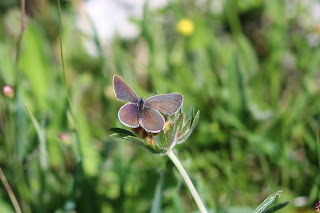Vizmigging, A new frontiers approach
Alright I stole that title format from some much better birders who developed the art of bird ID in the 80s to a new level.
I will not pretend to be at the very vanguard of this new movement but I think it will improve my call ID skills and want to do my bit in demystifying this area and expand its take up.
Essentially its nocmig during the day and I was inspired to try it after reading a blog post by Gavin Haig who decided to use his new recorder in the day time !
https://notquitescilly2.blogspot.com/2020/07/daymig.html
Having been interested in vizmig for many, many years this was way too exciting an addition not to try.
In essence then all you are doing is adding a sound recorder to your armory when standing on whatever hill, coastal headland, empty national park in Latvia, etc that is your chosen location for observing migration as it happens.
There is one big advantage over nocmig in my opinion, and when I say big it is simply enormous: Everything you see and record, or even hear and record COUNTS on your list. No mental gymnastics to stretch the definition of a house tick, county tick, year tick or life tick to include species that you would have connected with if only you had not been so lightweight as to actually sleep at night. Its simple, you see or hear it and then have the evidence to persuade sceptical friends, committee members, or others. This is especially important when you lack the necessary description taking skills or artistic ability to represent on a form what you saw. This of course is doubly difficult with fly-overs.
"Dear committee it went TIC and looked like a bunting"
"Actually it was clearly a rarity because it went SEEP as it flew over!
"I was attracted to the vanishingly small, rapidly flying, stratospheric, passerine because it went TEW"
All of these are unlikely to impress even county records committees, (and I know this partly because I used to sit on one).
So what do you need ?
1. A recorder
I chose the Olympus LS P1 as I knew someone locally who had one which he uses for nocmig and thought that he would be a good source of advice while I was taking the first steps. I was right in this and Paul has been generous with encouragement and a tutorial on the basics. It was also less than £100 which was important to me.
I did splash out on a wind shield as I intend to use it at exposed, windy sites, almost by definition.
After a try with it in the pocket of my rucksack I was concerned that it would drop out so my solution is to put it on a very small tripod that I already had. Fortunately a small adapter to do this was in the Olympus box when it arrived.
The tripod extends a few inches meaning I can put the recorder a few feet away behind a bush or behind my rucksack to further reduce wind noise if necessary....but you need to react quickly when the inevitable dog walkers approach !!
This is my full set up in situ
There is an old monument on my local hill which means I can get the recorder perched out of dogs way and also hang up my rucksack. The recorder, on the left has it's dead cat wind shield in place.
The rucksack also holds my bridge camera, in case anything large and slow comes by and, naturally a flask. Longer sessions sometimes mean lugging the seawatching chair up too.
If it was not so misty this morning you would be able to see Wales beyond the very large car carrier, which incidentally is on the line that our seabirds follow. If I had taken the photo the other way then all you could see would be Clevedon as my site is within the town.
So does it work ?
Well, I was astonished at how noisy Clevedon is. The town traffic, M5 and regular air traffic into Bristol airport are all very obvious when listening back to calls. I don't notice them when standing there and luckily they are at a much lower pitch than most bird calls so can be filtered out to some extent with the recommended "Audacity" software.
Two last items that you will need if you want to follow me down this particular rabbit hole... A set of headphones ( I paid £8 at B & M for a pair that work fine. (By the way, who is this Peppa Pig ? )
And lastly a notebook to record the time you start the recording and the times of interesting calls so you can rapidly find them again.
After all the above wordage here are some examples, for which you should bear in mind I have only done three short sessions actually in the field so its very early days
First a grey wagtail from my first day







Comments
Post a Comment